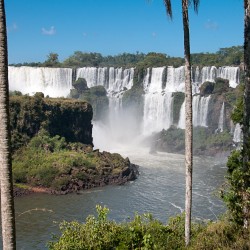When to go to Iguazu Falls

Iguazu Falls are the local name in Argentina for the renowned Iguassu Falls. This spectacular waterfall system is comprised of approximately 275 different falls. Although the falls can be experienced in either Brazil or Argentina, the majority of the falls actually occur on the Argentinean side.
The Argentinean side of the falls and surrounded areas are protected by Iguazu National Park with the Brazilian, Iguacu National Park serving the neighboring side of the falls.
When Lady Roosevelt first witnessed the falls her response was, “Poor Niagara.” This article explores the best times to explore the Argentinean side of the falls. If you are looking for more information about the Brazilian side of the falls, please explore the When To Go to Iguassu Falls article.
When to go to Iguazu Falls
Visitors will report that the better time to visit the falls depends on your focus. Some travelers like to go when water levels are higher. People that enjoy the outdoors often like to go during the shoulder season when water levels are a little lower and they have more access to trails, the island, and activities.
My recommendation for visiting the falls is when you will have a greater chance for blue skies and comfortable weather. Although the falls are not at their peak, you will still find them impressive. The rock faces peeking through the falls create more photographic scenes. These months would include March, parts of April, and August or September.
When to go to Iguazu Falls: Weather
Iguazu Falls are not too far from the equator making it a tropical area. This means that the weather is mostly accessible year-round. Although the temperatures do change, the most important question is about rainy and dry seasons.
December, January, and February represent the period where the longest and heavier rains occur. The good news is that this makes the falls more impressive with greater volume. These water levels may close access to San Martin Island. You may also discover that the rains have closed trails. Of course, the rainy seasons means you just might experience cloudy skies.
The hottest time of the year occurs during the summer months running from December through March. These higher temperatures bring more humidity. The high temperatures will be around 90°F with the lows dropping down to the mid-70s. This is the best time to go if you want to get into the falls and get wet. Driving the boats into the falls is exhilarating and provides visitors with a sense of the power of the falls. The pro is a good time to get wet with the con being a chance for trails and activities being closed.
April through most of June represents the dry season. This means that you have a good chance of seeing the falls under blue skies. Although water levels could be lower, the weather creates a great environment. If the levels get to low, the falls may lose their mystique and majestic nature. Less humidity will follow the cooler temperatures that come with the winter months of June, July and August. Here the highs will be in the mid-70s and the lows may drop down to 50°F.
The recommended time to explore Iguazu Falls considering the weather is probably during March, parts of April, August, and September. However, it is important to note that this is a tropical destination and it can rain any time of the day or year.
When to go to Iguazu Falls: Holidays
Many Brazilians and Argentineans take a vacation during the months of January and February which means the falls will be more crowded. This busy season also means you should expect full and higher rates. The Easter holiday represents another high season with many locals making their way to Iguazu Falls for their holiday celebration.
When to go to Iguazu Falls: Devil’s Throat
One of the things you want to decide before starting your day is whether you want to do Devil’s Throat early in the morning or later in the afternoon. Heading straight to Devil’s Throat first thing in the morning will allow you to experience the spectacular part of the falls with the least amount of crowds. The drawback is the sun is rising from the resilient side which means you will be looking directly into the sun as you look out over Devil’s Throat. The best viewing of this part of the falls as well is the best time of day for photography will occur in the late part of the afternoon. Here the sun will be behind you allowing for better views and pictures of Devil’s Throat.
When to go to Iguazu Falls: Upper and Lower Trails
The best time to explore the upper and lower trails is during the earlier part of the morning. The sun, which is rising from the Brazilian side, lights up the falls. As you navigate the trails and take advantage of the various lookouts, this will give you the best viewing of the false and the best lighting for photography. As the day wears on, the sun will become a negative factor for photography.
However, these trails give you access to the boats for exploring the river and falls. You will get wet which makes the latter part of the day more enjoyable because it is warmer. So this means you need to plan on exploring the Argentinean side of the falls in more than one day to take full advantage of the best time of day for each part.
